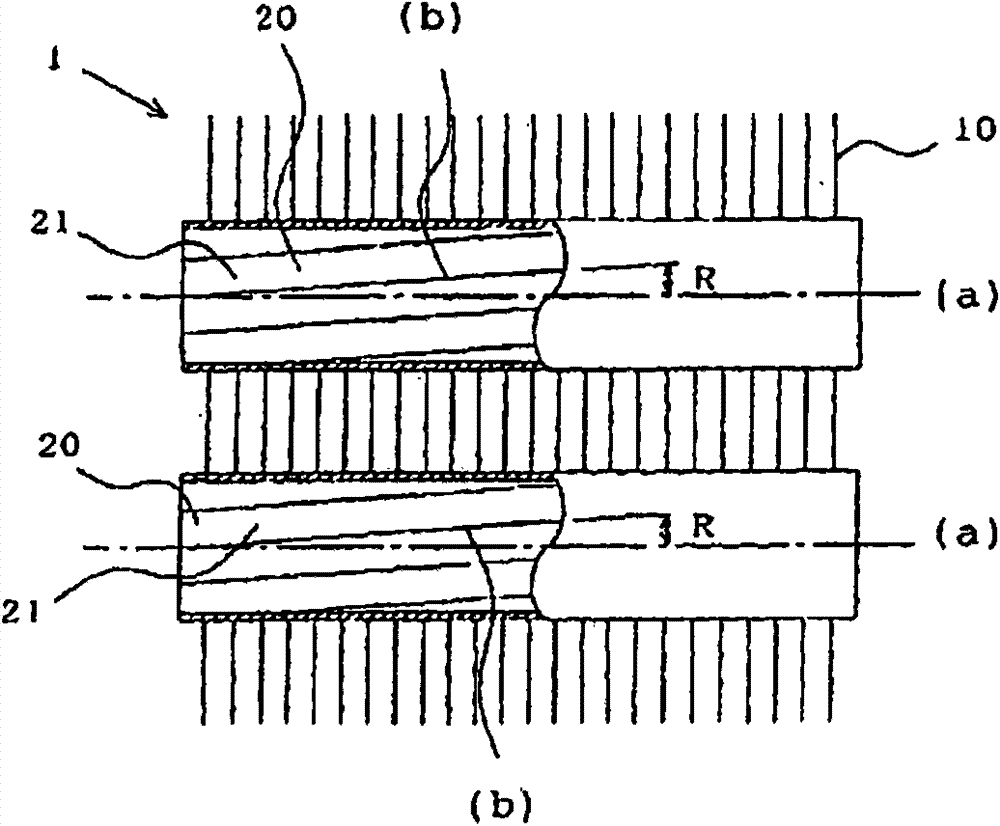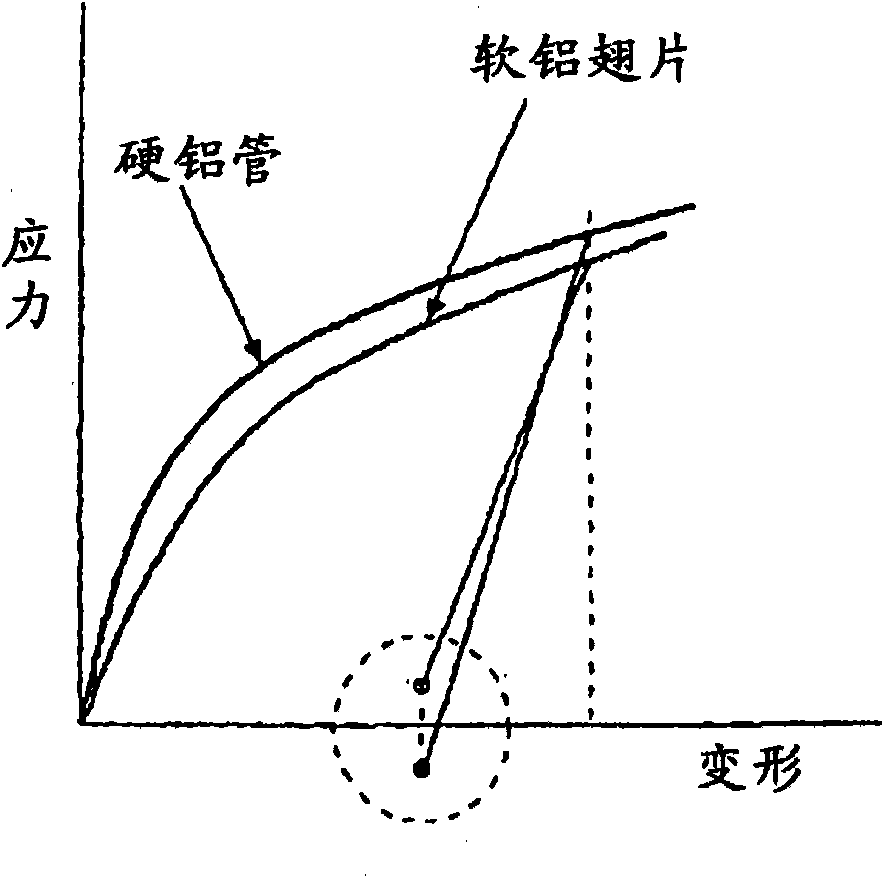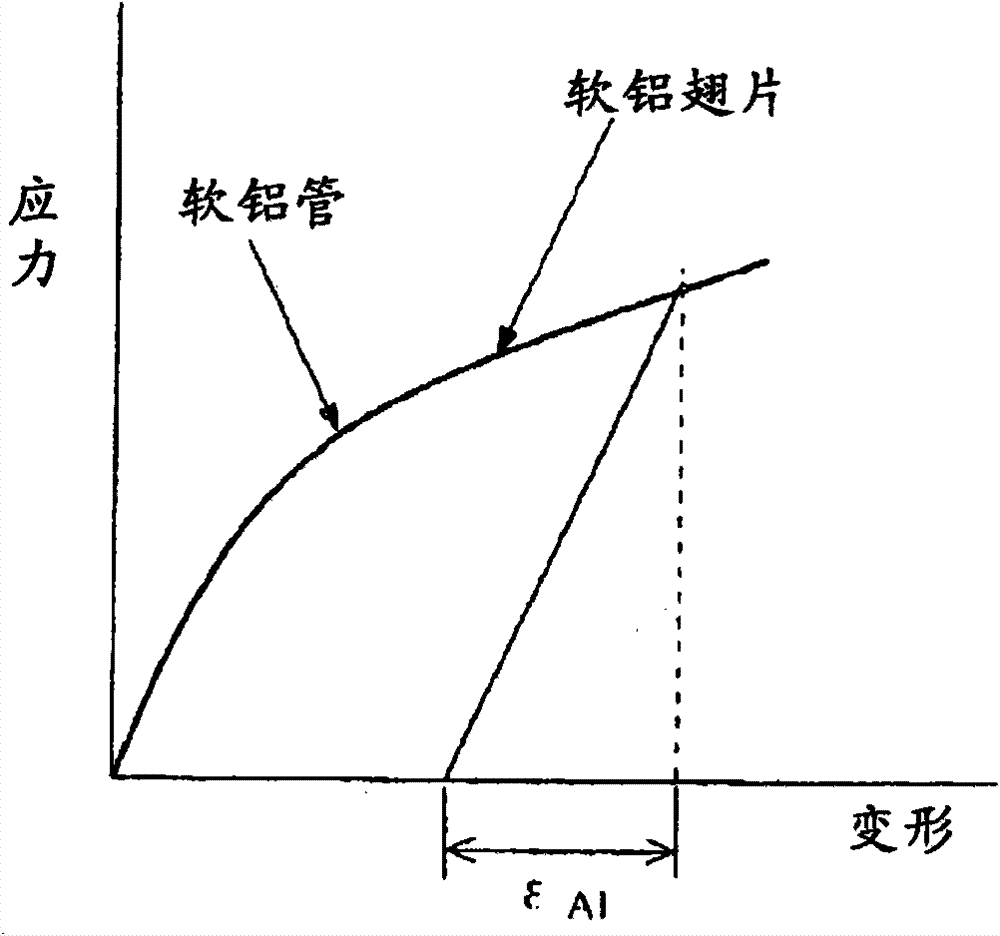Heat exchanger and air conditioner using the same
A heat exchanger and mechanical technology, applied in heat exchange equipment, evaporator/condenser, refrigerator, etc., can solve the problems of increased pressure loss in the heat transfer tube, failure to obtain heat transfer performance, collapse of the peak shape, etc. Achieves the effects of improved recyclability, improved tightness, and easy decomposition
- Summary
- Abstract
- Description
- Claims
- Application Information
AI Technical Summary
Problems solved by technology
Method used
Image
Examples
Embodiment approach 1
[0028] figure 1 It is a front cross-sectional view of the heat exchanger according to Embodiment 1 of the present invention cut in the vertical direction, figure 2 is a graph showing the relationship between deformation and stress of an aluminum tube with high deformation resistance and an aluminum fin with low deformation resistance, image 3 is a graph showing the relationship between deformation and stress of an aluminum tube with low deformation resistance and an aluminum fin with low deformation resistance, Figure 4 It is a graph showing the relationship between the lead angle and the increase rate of the evaporation pressure loss.
[0029] exist figure 1 Among them, the heat exchanger 1 has fins 10 and heat transfer tubes 20 passing through the fins 10 . The fins 10 are made of a (soft) aluminum-based material with low deformation resistance. In addition, the heat transfer tube 20 is made of (hard) aluminum or an aluminum alloy (hereinafter referred to as aluminum-...
Embodiment approach 2
[0035] Figure 5 It is a side cross-sectional view of the heat exchanger 1 according to Embodiment 2 of the present invention cut in the vertical direction, Figure 6 is enlarged Figure 5 A cross-sectional view of part A, Figure 7 It is a graph showing the relationship between the depth of the groove after pipe expansion and the heat exchange rate. In addition, the same code|symbol is attached|subjected to the part which is the same as or equivalent to Embodiment 1, and description is abbreviate|omitted (it is also the same in the following embodiment).
[0036] exist Figure 7 Among them, the heat transfer tube 20 with inner surface groove (refer to Figure 5 , Figure 6 ), the deeper the depth H of the groove 21 after tube expansion, the higher the thermal conductivity. However, when the depth H of the groove 21 exceeds 0.3 mm, the increase in pressure loss becomes larger than the increase in thermal conductivity, and the heat exchange rate decreases. In addition, w...
Embodiment approach 3
[0039] Figure 8 It is a side cross-sectional view of the heat exchanger according to Embodiment 3 of the present invention cut in the vertical direction, Figure 9 It is a graph showing the relationship between the number of tanks and the heat exchange rate.
[0040] exist Figure 9 In, because the heat transfer tube 20 with inner surface groove (refer to Figure 8 ) The more the number of grooves 21, the more the heat transfer area increases, so the thermal conductivity increases. However, when the number of grooves 21 exceeds 60, the cross-sectional area of the grooves becomes smaller, and the refrigerant liquid film overflows from the grooves 21, and the refrigerant liquid film covers the top of the peak, so the thermal conductivity decreases. On the other hand, when the number of grooves 21 is less than 40, the heat transfer area decreases and the thermal conductivity decreases.
[0041] Therefore, in the heat transfer tube 20 with inner surface grooves according to...
PUM
 Login to View More
Login to View More Abstract
Description
Claims
Application Information
 Login to View More
Login to View More - R&D
- Intellectual Property
- Life Sciences
- Materials
- Tech Scout
- Unparalleled Data Quality
- Higher Quality Content
- 60% Fewer Hallucinations
Browse by: Latest US Patents, China's latest patents, Technical Efficacy Thesaurus, Application Domain, Technology Topic, Popular Technical Reports.
© 2025 PatSnap. All rights reserved.Legal|Privacy policy|Modern Slavery Act Transparency Statement|Sitemap|About US| Contact US: help@patsnap.com



